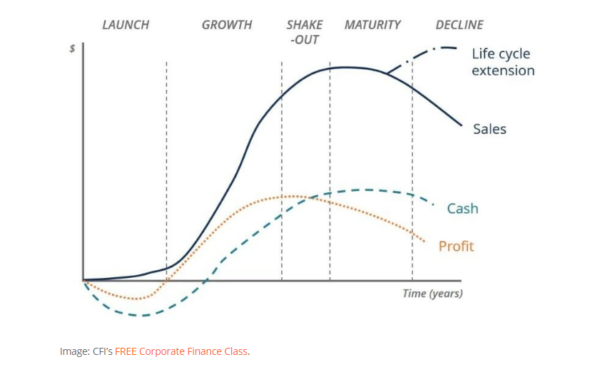With today’s technological and legislative changes, pharmacy enterprises must be more adaptable than ever. They must continually transform what they do and how they do it. As companies grow and change, they will generally pass through five life-cycle stages: 1) launch 2) growth 3) shakeout 4) maturity and 5) decline.
Depending on which stage a business is currently in its lifecycle, it may need changes to prevent decline. Examples of companies that were once well-known contenders but failed to reinvent themselves and ultimately suffered fatal decline include Blockbuster, Borders, and Tower Records. In today’s landscape, examples of companies in stage 5 decline are companies such as Kmart, JC Penney, and Sears. Example companies in their “growth” stage are Amazon, Tesla, Uber, Blue Apron, and Netflix. What pushed these companies into fatal decline? One difference is the ability to continuously reinvent their business model, allowing an extension of their life cycle.

What Makes an Existing Business Model Successful?
In this era of constant evolution, businesses need to offer more than just a better product or service. In 2003, Apple and its iPod combined innovative technology and design that revamped its business model. Once on the verge of bankruptcy, Steve Jobs’ return to the company brought decades of success. It wasn’t just that Apple was offering a new line of products—they were reshaping how people communicated, worked, and listened to music.
Below are some questions pharmacy firms could consider to gauge their resiliency to life-cycle decline:
- Has the company adopted the latest industry technology while ensuring a positive patient outcome?
- Does the company have a strategy for consistently attracting new clients and building interest in its product and service offerings?
- Does strategic planning include flexibility for new decisions and growth?
- How does the company compare to competing providers?
- What is the long-term outlook for existing recurring revenue?
- Does the company continuously provide value that ensures the well-being of its clients?
Consider how Amazon revolutionized the book industry and eventually, online retail. This is just one example of how a successful business can reshape its industry and drive growth. While many companies may find it difficult to reinvent their business model, it is significantly more difficult to stay competitive with an outdated model and complacency is a killer. Companies need to engage in continual performance review, taking the time to answer critical questions, in order to quickly identify problems and develop new plans, methods, structure, products, and services to address those problems.
Signals of Change
Two well-known consumer companies, Blockbuster and Borders, failed to respond appropriately to the signals of coming change. They were unable to stay on top of emerging technology that would change their markets.
For Blockbuster, when Netflix’s rental model virtually eliminated late fees, a major source of revenue for Blockbuster, they had a clear signal their model was at risk. They mistakenly held fast to an “if it isn’t broke, don’t fix it” paradigm. When Nextflix’s streaming services were introduced, a series of leadership decisions led to Blockbuster’s inability to catch up and remain relevant. With a business model that was heavily dependent on income from a non-core revenue channel, Blockbuster passed on an opportunity to acquire Netflix and eventually their services became obsolete.
Similarly, Borders failed to recognize when change was coming and were unable to adapt to a new technological landscape. By depending on Amazon for their initial bookselling, being slow to deploy their own website and failing to quickly develop their own e-book, they failed to maintain their lead ahead of the competition. Borders’ failure to identify where technology was headed also impacted their music sales. At a time when the iPod and digital downloads were taking hold of music lovers, Borders chose to heavily invest in CD sales. Like Blockbuster, Borders leadership made a series of decisions that made it impossible to remain relevant.
These are just two of many case studies that demonstrate why owners must pay attention to changing market signals. However, identifying change is not enough, companies must be adaptable and move quickly to minimize negative impacts and gain position with new opportunities.
Staying on top of market trends and responding quickly to competitive forces can prevent future problems. Michael E. Porter’s Five Forces Model which shape industry competition are 1) competitive rivalry, 2) bargaining power of suppliers, 3) bargaining power of customers, 4) the threat of new entrants, and 5) the threat of substitute products or services. He states that analyzing competition is one of the best ways to identify these threats, understand their potential impact, and assist with future planning. Knowledge of these as they relate to the company will assist in identifying change while providing the tools to create a competitive advantage.
Determining the ROI of Reinventing
Reinventing a business model is a serious undertaking, one that involves significant resources. It carries the potential pitfall of exorbitant costs and negatively affecting loyal customer perceptions. Taking from the Five Forces Model mentioned above, goal metrics need focus on the following: increasing profits, reducing costs and differentiation from the competition. Of course, a pharmacy is not able to reinvent their business model like Amazon or Netflix without massive capital investments and access to contracts and markets. That said, sooner or later, owners will need to decide if adapting to a new competitive model or expanding services will generate surplus returns or defend against a competitor. A pharmacy only needs to change their model if it makes a positive impact on the industry or their market. Innovatively restructuring and progressing beyond a better product or service will increase market share and customer retention. If the reinvention plan does not satisfy performance goals, then consider joint ventures, equity partnerships and exit strategies. At all costs, owners must avoid complacency and other leadership mistakes that could eventually lead to the demise of the company, like the examples above.


